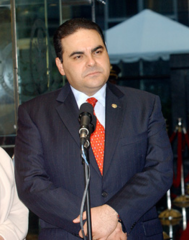Antonio Saca
 | |
| Data i miejsce urodzenia | |
|---|---|
| Prezydent Salwadoru | |
| Okres | |
| Przynależność polityczna | |
| Poprzednik | |
| Następca | |
| Odznaczenia | |
Elías Antonio „Tony” Saca González (ur. 9 marca 1965 w Usulután) – salwadorski polityk, prezydent kraju w latach 2004–2009.
Życiorys
Pochodzi z rodziny emigrantów palestyńskich; pracował jako biznesmen oraz radiowy dziennikarz sportowy.
21 marca 2004 został wybrany na prezydenta Salwadoru z ramienia partii centroprawicowej ARENA (Narodowy Sojusz Republikański). 1 czerwca 2004 objął urząd, zastępując innego polityka ARENA, Francisco Floresa. Kandydatura Sacy, który pokonał swoich rywali (głównym przeciwnikiem był Schafik Handal) już w pierwszej turze wyborów, była zdecydowanie wspierana przez rząd USA.
1 czerwca 2009, po porażce partii ARENA w wyborach prezydenckich, na stanowisku szefa państwa zastąpił go Mauricio Funes[1].
W 2018 został skazany na 10 lat pozbawienia wolności po tym, jak przyznał się do defraudacji funduszy publicznych i prania brudnych pieniędzy w wysokości przekraczającej 300 milionów dolarów[2].
Przypisy
- ↑ Salvador leftist leader sworn in, BBC News, 1 czerwca 2009
- ↑ 10 lat więzienia. Były prezydent skazany, tvn24.pl, 13 września 2018 [dostęp 2018-09-13].
Media użyte na tej stronie
Elías Antonio ("Tony") Saca González, current (2007) President of El Salvador.
Coat of arms of El Salvador
- The coat of arms has the words (REPÚBLICA DE EL SALVADOR EN LA AMÉRICA CENTRAL) in a bold and Heavy, Sans Serif Boris Black Bloxx typeface, in a golden amber color
- The nacional motto (DIOS UNIÓN LIBERTAD) in bold version of Trajan (typeface), Roman type, Roman square capitals. The letters are colored black within a golden amber scroll.
- The date (15 DE SEPTIEMBRE DE 1821) in bold version of Trajan (typeface), Roman type, Roman square capitals.


